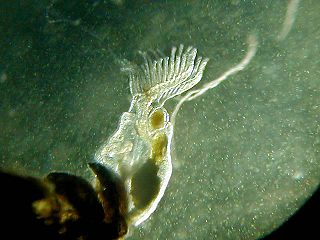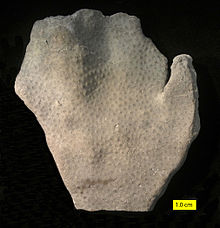
Bryozoa are a phylum of simple, aquatic invertebrate animals, nearly all living in sedentary colonies. Typically about 0.5 millimetres long, they have a special feeding structure called a lophophore, a "crown" of tentacles used for filter feeding. Most marine bryozoans live in tropical waters, but a few are found in oceanic trenches and polar waters. The bryozoans are classified as the marine bryozoans (Stenolaemata), freshwater bryozoans (Phylactolaemata), and mostly-marine bryozoans (Gymnolaemata), a few members of which prefer brackish water. 5,869 living species are known. At least, two genera are solitary ; all the rest are colonial.
Stenolaemata are a class of exclusively marine bryozoans. Stenolaemates originated and diversified in the Ordovician, and more than 600 species are still alive today. All extant (living) species are in the order Cyclostomatida, the third-largest order of living bryozoans.

Phylactolaemata is a class of the phylum Bryozoa whose members live only in freshwater environments. Like all bryozoans, they filter feed by means of an extensible "crown" of ciliated tentacles called a lophophore, and like nearly all bryozoans, they live in colonies, each of which consists of clones of the founding member. Unlike those of some marine bryozoans, phylactolaemate colonies consist of only one type of zooid, the feeding forms known as autozooids. These are supported by an unmineralized "exoskeleton" made of gelatinous material or protein, secreted by the zooids. The class contains only one extant order, Plumatellida.
Chasmatopora is an extinct genus of bryozoans which existed in what is now Mongolia, China, Estonia, Russia, Poland, Argentina, the United States and Canada. It was described by Alcide d'Orbigny in 1849, and the type species is Chasmatopora tenella, which was originally described as a species of Retepora by Eichwald in 1842.
Fenestrata is an extinct order of bryozoan, dating from the Upper Arenig. Most fenestrate bryozoans formed net-like colonies, often in funnel- or fan-shaped forms, with a single layer of zooids facing one direction. The colony shape served as a filter-feeding apparatus that water currents flowed through, with autozooecial apertures only on the side of the colony facing into the current. This colony structure was vulnerable to predators, so some fenestrate bryozoans produced skeletal superstructures, likely to strengthen or protect the colony, and others had protective spines surrounding their autozooecial apertures.
Ceramopora is an extinct genus of bryozoan of the family Ceramoporidae. It is one of the earliest genera of bryozoans. Its colonies were thin and discoid, with large autozooecia, abundant communication pores, lunaria, and monticules with depressions in their centers. It had no acanthostyles or diaphragms, distinguishing it from Acanthoceramoporella.
Paleontology or palaeontology is the study of prehistoric life forms on Earth through the examination of plant and animal fossils. This includes the study of body fossils, tracks (ichnites), burrows, cast-off parts, fossilised feces (coprolites), palynomorphs and chemical residues. Because humans have encountered fossils for millennia, paleontology has a long history both before and after becoming formalized as a science. This article records significant discoveries and events related to paleontology that occurred or were published in the year 2015.
Acanthoceramoporella is an extinct genus of cystoporate bryozoans from the Ordovician period.
Dekayia is an extinct genus of Ordovician bryozoans of the family Heterotrypidae. Its colonies can be branching, encrusting, or massive. All species have acanthopores in varying sizes and numbers. The autozooecia appear angular or sub-angular viewed through a cross-section of the colony, and their walls are distinctively undulating or crenulated. Maculae generally protrude from the colony surface very little or at all, and can contain unusually large autozooecia and a cluster of mesozooecia in their centers.
Homotrypa is an extinct genus of bryozoans from the Ordovician and Silurian periods, known from fossils found in the United States. Its colonies are branch-like and have small monticules made of groups of three or four larger zooecia slightly protruding out from the main surface of the colony. In cross section, the zooecia are erect in axis and gently curve toward the surface of the colony.
Eridotrypa is an extinct genus of bryozoans of the family Aisenvergiidae, consistently forming colonies made of thin branches. Diaphragms are very common in colonies. Distinctively, in the exozone there are serrated dark borders separating the autozooecia.
Prasopora is an extinct genus of bryozoan belonging to the family Monticuliporidae, known from the Middle Ordovician. Its colonies were disc-shaped or hemispherical, flat on bottom and convex on top, and had very abundant mesopores; in the case of the species P. insularis its zooecia were isolated from each other by the numerous mesopores surrounding them. It is very similar to the genus Monticulipora, and some bryozoan species have been assigned to both genera at different points in their study, but it is mostly distinguished by having more mesozooecia, rounder autozooecial apertures, relatively few acanthostyles and diaphragms and cystiphragms equally distributed in the autozooecia.
Metastenodiscus is an extinct genus of Triassic trepostome bryozoans of the family Stenoporidae. It is distinct from Stenodiscus because of the presence of cystiphragms and the presence of a wide range of sizes of acanthostyles.
Moyerella is an extinct genus of bryozoan of the family Arthrostylidae, known from the Upper Ordovician and Lower Silurian periods. Its colonies are branching or segmented, generally articulated (jointed). Its autozooecia are short tubes that appear triangular in cross section within the endozone, bending abruptly when reaching the exozone. The autozooecial apertures are round and aligned into diagonal rows, and paired heterozooecia occur between the autozooecial apertures.
Kukersella is an extinct genus of bryozoan of the family Crownoporidae, known from the Ordovician period. Its colonies consist of cylindrical branches growing from an encrusting base.
Crassaluna is an extinct genus of cystoporate bryozoan of the family Anolotichiidae, known from the Ordovician period. It had an encrusting growth habit or, in the case of C. fungiforme, formed cup-shaped colonies. Its colonies possessed a vesicular skeleton and monticules. Its cyst-like interzooecial spaces are a distinguishing feature.
Lichenalia is an extinct genus of cystoporate bryozoan of the family Rhinoporidae, known from the Upper Ordovician to the Middle Silurian. Its colonies could form hollow branched or tube-shaped colonies or have an encrusting growth habit. It possessed prominent lunaria and a vesicular skeleton. As in other members of Rhinoporidae, the vesicular skeleton contained tunnels that appeared like ridges on the surface of the colony. Their purpose is unknown, but they may have been used as brooding chambers.
Dybowskites is an extinct genus of bryozoan of the family Ralfimartitidae, found in the Ordovician and Silurian periods. It forms branching, frond-like, or sometimes segmented colonies. In cross-sections of the colonies, the tubular autozooecia are seen growing alongside the branch axis and then bending abruptly to reach the colony surface at a perpendicular angle. There are many mesozooecia and large acanthostyles that protrude from the colony surface.
Tarphophragma is an extinct genus of Middle and Upper Ordovician bryozoans of the family Halloporidae. Its colonies began from an encrusting base and grew into branching structures. Raised maculae made from mesozooecia and large autozooecia covered the colony's surface, and its autozooecia were arranged in a disorderly pattern. Its interzooidal budding pattern and integrate wall structure distinguish it from other genera.
Palaeostomata is a superorder of extinct stenolaemate bryozoans, including all extinct orders within Stenolaemata and excluding the order Cyclostomata, which is the only extant stenolaemate order. Palaeostomates are sometimes called "stony bryozoans" because they are heavily calcified, making them ideal candidates for fossilization. They are distinct from cyclostomes because they lack calcified exterior walls above the basal lamina and because their zooecial tubes are transected by calcitic partitions, such as diaphragms.




